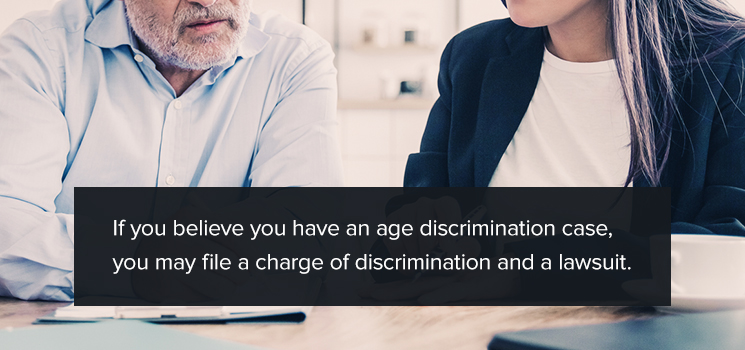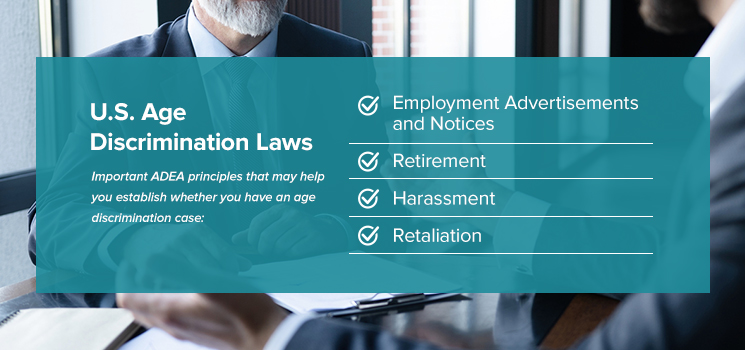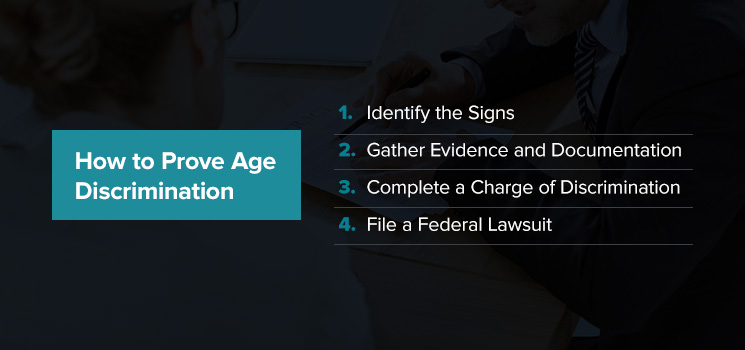Although age discrimination is illegal in the U.S., many employees still regularly deal with ageism. Employers may miss out on hiring valuable talent if they have discriminatory hiring practices, and employees may feel more stressed and less valued in a hostile work environment. Companies waste money and resources handling lawsuits and may gain a negative reputation.
Age discrimination may pervade the following practices:
- Hiring and firing
- Promotions and demotions
- Training
- Pay and benefits
- Harassment and disrespectful behavior
If you believe you have been subject to age discrimination, you may be considering filing an age discrimination lawsuit. Below, you’ll learn how to recognize ageism and the steps for filing an age discrimination lawsuit.
Can You Sue Your Employer for Age Discrimination?
Ageism is incredibly harmful to workers and often negatively impacts their careers. While federal legislation only protects workers older than 40, age discrimination affects both older and younger workers. While employers may incorrectly assume older workers are less flexible and not technologically savvy, they may stereotype younger individuals as lazy and less skilled.
Understanding U.S., state and local age discrimination laws can help you recognize whether you may have been a victim of ageism. If you believe you have an age discrimination case, you may file a charge of discrimination and a lawsuit.
U.S. Age Discrimination Laws
The U.S. Equal Employment Opportunity Commission (EEOC) handles age discrimination cases under the Age Discrimination in Employment Act (ADEA) of 1967. ADEA protects workers older than 40 from age-based discrimination when working for government organizations or private companies with at least 20 employees. If someone files a discrimination claim, their employer cannot retaliate against them legally.
Here are the five important ADEA principles that may help you establish whether you have an age discrimination case:
Employment Advertisements and Notices
Employers are prohibited from releasing notices and advertisements that include age limitations, preferences or specifications. These advertisements or notices may express their preference for older individuals. However, they may not use language such as they prefer “recent college graduates” or applicants “age 25 to 35.”
In some instances, companies are allowed to establish an age limitation if it is necessary to perform the required duties of the role, such as serving alcohol. This is known as Bona Fide Occupational Qualifications (BFOQ).
Retirement
The ADEA allows organizations to take employment actions based on a worker’s retirement eligibility or status when it is based on a factor other than age. This means that if you believe a company is encouraging you to retire due to your age, you must find evidence that no other factors are responsible for this action.
Some evidence might include records that other employees were also coerced into early retirement. You might also provide performance results and other documents that prove you are still fit to perform your job duties. Extensive research on the typical retirement age for employees from similar or competitor companies in the same area may also support your case. Working with a knowledgeable employment law attorney may help you find the relevant research.
Harassment
You might experience harassment based on your age from various people in the workplace, such as a supervisor, co-worker, employer, contractor or a supervisor from another area. The law generally does not prohibit offhand comments, simple teasing and non-serious isolated incidents.
Still, the ADEA considers these actions illegal when they are so frequent that they create an offensive or hostile work environment. It is also illegal when the harassment leads to being demoted or fired.
Retaliation
The ADEA law prohibits any individual or employer from retaliating against someone who opposes an employment action prohibited by the ADEA. This includes filing a charge of employment discrimination, participating in a discrimination proceeding, serving as a witness or cooperating with an internal investigation. If you believe you have experienced retaliation for one of these actions, an employment lawyer may be able to tell you whether it is worth filing a charge against your employer.
How to Prove Age Discrimination
Proving age discrimination involves understanding what the law classifies as age discrimination. Then, identify how they relate to your situation and gather the correct evidence to file a charge. Here’s how to prove and potentially win an age discrimination case in four steps.
1. Identify the Signs
Age discrimination happens when a company unfairly treats an employee. It can be direct, such as if an employer promotes a younger worker instead of an older co-worker with the same qualifications. Age discrimination can also appear in more indirect ways. For example, the tech industry notoriously hires younger individuals, with workers older than 40 feeling that their age might be an issue when applying for another tech job.
Signs of workplace ageism include:
- Derogatory comments and harassment.
- Demotions or easy assignments that make an employee feel less valued or competent.
- Excluding employees from meetings or isolating their desks.
- Encouraging older team members to retire by providing appealing early retirement packages or specifying a mandatory retirement date.
- Unexpectedly conducting increased performance reviews despite consistent work quality and subjecting workers to harsher discipline.
2. Gather Evidence and Documentation
This step is crucial in building an age discrimination case with a more desirable outcome. Proving age discrimination requires understanding age discrimination laws and how to document evidence. The law considers age discrimination to be legitimate if:
- The employee is in the protected age class of over 40 years of age.
- The employee’s job performance was satisfactory.
- The employer discriminated against an employee.
- An employer treats younger co-workers better even though they have a similar role or qualifications as older team members.
You may prove age discrimination by gathering all documentation related to your performance reviews, promotions, raises, disciplinary actions and interactions with management. These may be useful if you have consistently provided positive performance and have still been denied advancement opportunities.
As soon as you experience age discrimination, you can also write about the incident while it is still fresh for more accurate details about the encounter. Additionally, if you know any colleagues who have witnessed discriminatory behavior or statements, ask them to provide a testimony to help strengthen your case.
3. Complete a Charge of Discrimination
Employees who feel their employer has subjected them to age discrimination — or other forms of discrimination in the workplace — can file a charge of discrimination with the EEOC. This document certifies that an employer committed age discrimination. You must file a charge of discrimination within 180 days of the incident if you wish to preserve both federal and state claims. This step is essential to file a lawsuit.
Take the following steps to file a charge of discrimination:
- Submit an online request: After notifying the EEOC of discrimination, you will have an interview with a professional at the EEOC. An EEOC staff member can provide guidance for the best next steps.
- File with the EEOC portal: If you decide to proceed with your case after the EEOC investigation, you can complete a charge of discrimination with the EEOC public portal. If you have fewer than 60 days to file a discrimination case, the EEOC will provide instructions for expediting the process.
When reviewing a charge, the EEOC considers several factors, including the evidence’s strength and whether the case’s issues may significantly impact the EEOC’s larger mission to fight workplace discrimination.
4. File a Federal Lawsuit
If you want to move forward with the case after filing a charge of discrimination, you can then file a lawsuit. Age discrimination lawsuits under ADEA are unique in that they don’t require a Notice of Right to Sue. You must wait 60 days after filing a charge of discrimination to file a lawsuit and must file within 90 days of receiving the notification that the EEOC is done with its investigation.
In most cases, the EEOC can only file a lawsuit after determining reasonable cause that discrimination occurred and both parties cannot facilitate the situation through conciliation. However, you can request a Notice of Right to Sue to file a lawsuit before the EEOC finishes reviewing a charge.
Submit a request via the EEOC online portal or the office handling your charge. If 180 days have passed since the EEOC started its investigation, you are legally entitled to receive the notice. Otherwise, the EEOC will only give you the notice if it cannot finish investigating in 180 days.
Filing a Lawsuit in Pennsylvania
Beyond filing on the federal level, you can also file a charge with Fair Employment Practice Agencies (FEPAs) on the state and local levels. Some people file with these agencies because of state laws that offer more extensive worker protection. For example, Pennsylvania’s laws cover employees of smaller companies with at least four employees. States may also interpret laws differently or provide various types of compensation to discrimination victims.
The Pennsylvania Human Relations Act is the state legislation that dictates discriminating against employees over 40 years old based on their age is illegal. If you feel your employer has violated your rights under the Pennsylvania Human Relations Act, you may file a discrimination claim with the Pennsylvania Human Relations Commission (PHRC). The PHRC cooperates with the EEOC to process claims. Therefore, you only need to file with either the PHRC or EEOC.
Contact Weisberg Cummings for a Free Consultation
If you feel you may have an age discrimination case, an experienced age discrimination lawyer might help. At Weisberg Cummings, P.C., our team can handle many employment claims for Pennsylvania workers, including:
- Discrimination
- Employer retaliation
- Contract disputes
- Wage and hour disputes
- Wrongful termination
- Sexual harassment
- Family and Medical Leave Act (FMLA)
- Americans with Disabilities Act (ADA)
- Class action
Our team has more than 40 years of combined experience to bring real-world experience to your case. We are happy to work with you to discuss your options. Contact us today for a free consultation!





